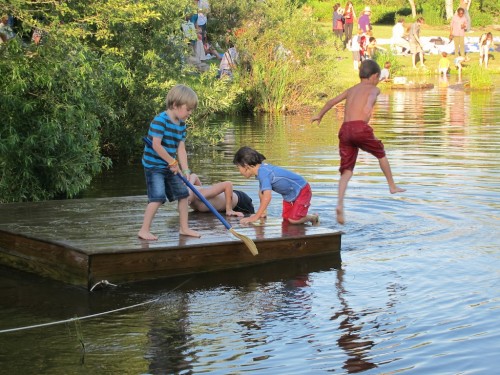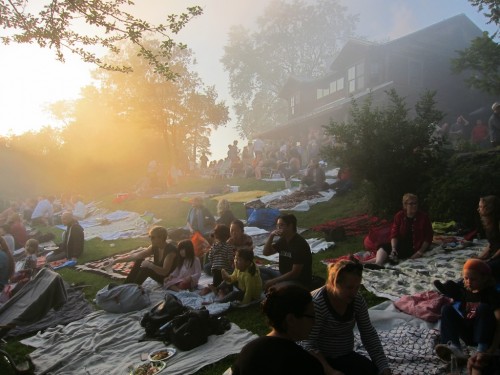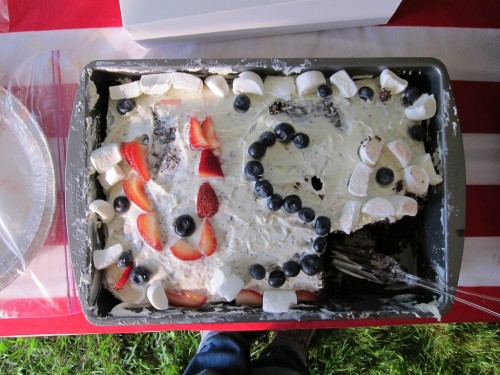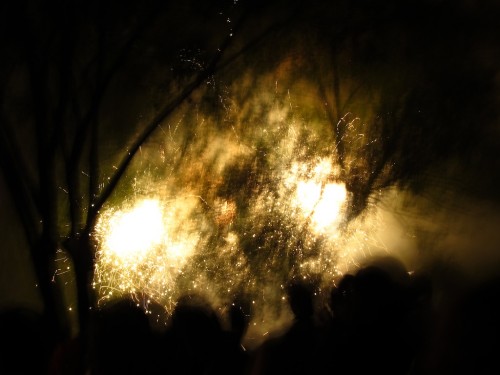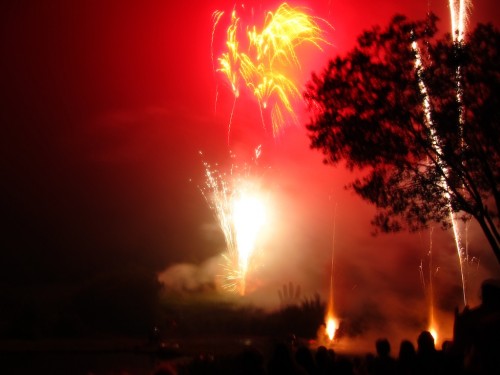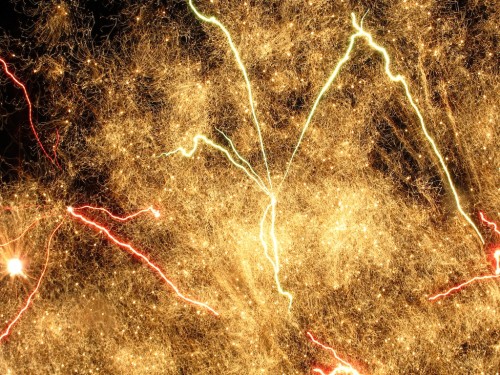SOMETHING STRANGE HAPPENS in Delaware County on or around the 4th of July. This year it’s today, June 30th, not even July at all. It’s as if a wormhole opened and the New York City subway developed a new stop, as if somehow the F train or the J/M found its terminus to be not Brooklyn but a field in Bovina, N.Y. As if Bovina, N.Y. were really part of Brooklyn. The scene is that surreal, that full of wonder.
Blankets are spread; kids hop and fly through the air, which is ripped by the screech of bottle rockets. The children dive off a floating dock into a pond sending water splashing at the shore. Conversations overheard include people asking how each other’s “work” is, “work” here being code for creative work, for novels being written and paintings being painted. There are tents of food (almost like the Brooklyn Flea) and women in floaty white dresses, sporting a hippy look as if that’s what you wear in the country and not a fashion catalogue version thereof. Stars abound. Not in the sky but famous people, generally the kinds of famous people you and I think are “cool.” I’m talking Amy Sedaris, Adam Horovitz and Alan Cumming, not to mention Steve Martin and Ben Stiller.
Last year a clutch of preteen girls swarmed up to Stiller and asked to take his photograph and to receive his autograph. The whole thing was vaguely embarrassing. Everybody watched or tried not to. Unlike Sean Beaudoin and his snakes on a plane moment (of sorts) I can never recognize stars. I ran into Julianne Moore in the local realtor’s office and someone had to tell me who she was. I was only thinking, what luminous skin this woman has and what a lovely peasant top…. So, here too with Stiller. After which I thought, wow, he’s short, like Tom Cruise. But, he was easy with the kids and obliging. Afterwards there was a collective sigh, a kind of oh-that’s-sweet. And, that sweetness abounds. It’s as palpable as the smell of fresh-cut grass because everyone is invited from farmers and firefighters to film stars. They’re all gathered together here in a field nestled against a ridge where a meadow gently slopes down to a pond and stream making for a natural ampitheater. We are here on Peter Schjeldahl’s lawn. The scene is nearly enchanted.
Now lest you think “Notes From Bovina” is solely dedicated to the New Yorker’s art critic, it’s not. This occurrence is happening today, tonight.
This is the day that he and his wife Brooke Alderson have their potluck and fireworks party, and let me tell you those pots are lucky or, at least, those who get to eat from them. How many cakes can you have frosted in red, white and blue? How many rhubarb pies with lattice crusts shaped like flags? The sheer number of cupcakes arranged on trays to form the stars and stripes is staggering. Just pondering the scale is enough to bring on a sugar coma. There are at least a dozen potato salads. You want a sweet potato salad? Check. You will find it here. However, despite what the New York Observer wrote last September about Schjeldahl and Alderson’s shindig, there is no venison or bear. The locals bring the same things as everyone else. Plus bear and venison are out of season now, and while bear is occasionally eaten here in winter (at the annual hunter’s dinner at the Andes Hotel, say), its taste is enjoyed by a very few. (I also bristle at the idea that locals and city folk are that different). That we are all here, however, these legions getting along, is a feat arranged by Alderson. She marshals the forces and sets the scene. I am continuously amazed by her graciousness. Just imagine having a thousand people on your lawn!
The scene was not always this packed. It all started back in the late Eighties. In 1988 it was just bottle rockets and beer and a bonfire for some friends up from the city.
That summer both Schjeldahl and I were setting off bottle rockets, only I had never heard of Bovina or Delaware County. For that matter I’d barely ever been in Brooklyn – certainly no further than Williamsburg. Which is where I was on the 4th of July in 1988. I think Jim Lewis once wrote that the day burns a hole in the calendar. That year it did for me on a fire escape, aiming bottle rockets in the vague direction of the bridge. I trailed behind a boy, no older than 19. Enthralled, enthusiastic, I tilted my head in a sympathetic cant, watched the movies he’d made with his roommates – and sketched out a future together in my mind. We’d met the day before.
I followed him to Manhattan to buy fireworks. We came back, drank Rolling Rock and set them off aiming at the bridge. It ran close to his loft. The J train shook the fire escape. That same day that same year, Schjedahl was writing a beautiful essay for the legendary and short-lived 7 Days magazine where he called bottle rockets as “maybe the world’s single most satisfactory manufactured object,” and describes setting them off: “Stand it upright, ideally in a beer bottle, and ignite. Fsss. Swish trailing sparks and smoke. A hundred feet or so up, a flash followed by a crisp bang. Then if it’s daylight (who can wait for sunset?), you see the bare red stick drifting down.”
I’m sure none of my missiles hit the bridge. At least, I hope not. Schjeldahl wrote of their danger. And, that his own “joy in fireworks is regressive. You bet it is,” he writes, engagingly “– and none too soon after long months of approximating grown-upness. With fireworks, I discover old, inchoate excitements probably pertaining to a boy’s dim anticipations of sex.” Inchoate, sex, fireworks, explosions. He nails it all. Here, though, on the same day of the same year with my own inchoate longings, shooting off bottle rockets and dreaming of something far more dramatic, our paths divide for the next couple decades until now, when I find myself in Schjeldahl’s field.
This party is not just a wormhole onto Brooklyn but to my own past. The two collide one day each year, and I fully expect bottle-rocket guy’s old roommates to show up. I run into people I haven’t seen for decades, people from past lives I thought I’d shed, friends of friends and friends of friends of exes. It’s haunting. It feels straight out of Dickens, only instead of Christmas, I’m being followed by ghosts of boyfriends past. My first year I drank too much, perched on a remote boulder and then buried my head on my husband’s lap, as close to hiding in the sand as I could get.
I’ve always felt I could escape my history, that it didn’t define me or (ha-ha!) I could define it for myself. After all, going from New York to London and London to Margaretville (of all places), what – or who – could follow me?
Those ghosts of boyfriends past could, of course, and those women in the diaphanous white dresses (like ghosts themselves), not to mention the men and their straw boaters, the facial hair, the irony…. This one night in the field is where my Upstate and past lives merge, and for some this might be fulfilling, like coming full circle. For me it’s often overwhelming. At least, I now know how to handle it. I’m prepared.
~
As dark settles in, a small army of people dot the flats below the field. Each person is marked by a small circle of light from a headlamp. The lights bob and weave. The crowds hush; a sense of when soon, what soon, now? is palpable enough to feel. Seemingly spontaneously someone starts singing “The Star Spangled Banner”, and people rise. The crowd is such that this show of patriotism would seem ironic, but it’s not. This is a soaring moment of communal pride: that a field includes all these people, that Peter and Brooke have opened their yard to all, near and far. Folks make the pilgrimage from states away to share in this. There is a joy too that everyone is patriotic – even (especially) those with English and French and Swedish accents; that there is a mix of nurses and EMTs, firefighters, loggers, excavators, insurance agents, realtors, builders all congregating (that being a key word because now we feel united like a congregation) with conceptual artists and boutique owners, art dealers, art critics and artists of many and any stripe, plus those Brooklyn types, the artisanals, the ones who make artisanal cheeses and artisanal cured meats, and artisanal charcuterie. Here, the art and artisanal, local and not, are represented and invited. In a field dotted with fireflies, where children have run and set off bottle rockets, we sing together the national anthem. We are all standing, some with hands on their hearts, and nearly the entirety of the crowd is off key, but that doesn’t matter because this is the moment when those anxieties, mine and others, that bloomed by the light of day are swallowed in the swell of voices and the anticipation of what’s to come.
A chant begins: Peter, Peter, Peter…. Everything before, the countless cakes and potato salads, wine and beer, the burgers and frankfurters, the singing and star spotting, is prelude. Now it is Schjeldahl’s show.
Peter himself is pale as if he has never spent a day in the sun. He smokes despite the fact that cigarettes have fallen from fashion and are virtually illegal. He has been called “aggressively shy” by his friends. I’ve seen him try to start conversations that die, floating off on a breeze. He’s a poet and a critic, which perhaps makes him doubly cursed in the shyness department. He can be hounded at parties where people yell after him, “That piece was so great. That thing you wrote on art fairs… ” Yet, this man, who is a poet and critic, who has written about Rembrandt, “We see what he sees and, by the sorcery of paint, as he sees—a consciousness both outward and inward, alive in a moment forever,” words that make me shiver, is a pyro. In short, he likes to make things go boom.
Adam Horovitz (who a couple years filmed the proceedings for a feature length documentary to be titled Terror and Delight) has called Schjeldahl “a rock star,” for what he does here in the field. The next thirty minutes are his.
Paper lanterns lift in the air. It’s spiced by sighs, and a tree lights up in a blaze of practically biblical glory. The branches shiver with exploding light. Fireworks take to the air. In another tree they spell out words. In 2008 it was “Hope” and “Obama.” Another year it was “peace.” In this field that was once farmland you can forget everything you’ve ever known about fireworks. Macy’s? The annual extravaganza on the Mall? The ones rolled out recently for the queen’s jubilee? They have nothing on this. This is art. This is obsession.
A baroque chiaroscuro is written in flame and gunpowder. Its smell carries on the breeze. There are stories of singed hair and sweaters from those who got too close to the explosions. Fireworks here are returned to the awesome, that is, to inspiring awe and glory. Real danger replaces those corporate and government sponsored displays drained of all energy and emotion. Everything shakes, born aloft, torn between the contradictions – countryside and city, fire, nature, danger, pastoral surrounds, hipsters and locals, patriotism and irony – all are represented. This is what a poet, one so private and shy, annually manages to achieve in a blaze of glory.
~
On Memorial Day each year at the same party where Peter was recently accosted and praised much to his embarrassment, he tries out different fireworks, things that go by names like “Shock & Awe” and “Air Assault,” and they look like, well, fireworks. There are no flaming words, no burning bushes, no trees alight casting limbs in shimmering silhouette. A month later, though they’re transformed. I’ve heard from one who helps him that each spring Schjeldahl’s fireworks’ purveyor gives him a box of new ones to try out. Peter and his cohorts take notes which run along the lines of “AWESOME ….” He then makes a list of what he wants, goes to his supplier in deepest Pennsylvania and hauls them back. Only as the 4th looms he begins to panic that he doesn’t have enough and returns again. How he gets from shooting pink stars to a panoply of colors painted across the ridgeline is a mystery. That, however, is art. It is the inchoate (to borrow Peter’s word). It is that act of translation which defies simple materials (here: gunpowder, binder and oxidizer, not to mention the titanium, strontium and copper needed to become silver-white, red and blue) to become this:
Schjeldahl is this person with a double life, poet and pyro, who likes blowing stuff up, who wrote in 1988 about the “inchoate excitement” and the transcendent joys of “Fourth of July bottle-rocketing.” He also describes one municipal display he fell for: “A centennial celebration of the Brooklyn Bridge was capped by having that adorable structure spew fire into the East River night. It’s a matter of which symbols your heart buys into.”
It is he who, with his wife, makes me realize just which ones I do. Thanks to the two of them I can see 24 years later that my life is a continuum, here on this stretch of field in a mountain pass by a stream with fireflies and fireworks, where now oohs and ahs and applause fill the air. This is the sublime.
He ends his essay with this:
“Patriotism? Well, sure. It’s a likable country that maintains such a tradition when you come to think of it. But you’re not obliged to. The point is not to congratulate America, but to just go ahead and be American in the classic mold: free, somewhat obnoxious and up for a good time.”

